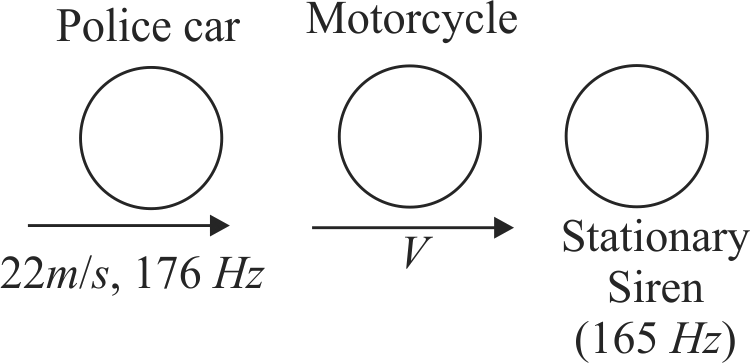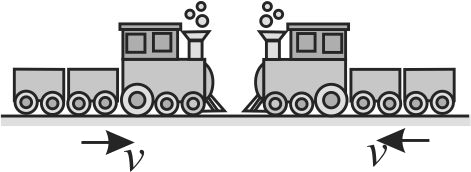354738 Two trains ' \(A\) ' and ' \(B\) ' are moving away from one another with a speed of \(720\,kmph\). The apparent frequency of the whistle blown by as heard by the passenger of the train ' \(B\) ' is (velocity of sound in air is \(350\;m{s^{ - 1}}\) ) (given whistle frequency \(1100\;Hz\))
354740
A police car moving at \(22\;m{\rm{/}}s\) chases a motorcyclist. The police man sounds his horn at \(176\;Hz\), while both of them move towards a stationary siren of frequency \(165\;Hz\). Calculate the speed of the motorcycle. If it is given that the motorcyclist does not observe any beats: (Given velocity of sound \(330\;m{\rm{/}}s\) )
354738 Two trains ' \(A\) ' and ' \(B\) ' are moving away from one another with a speed of \(720\,kmph\). The apparent frequency of the whistle blown by as heard by the passenger of the train ' \(B\) ' is (velocity of sound in air is \(350\;m{s^{ - 1}}\) ) (given whistle frequency \(1100\;Hz\))
354740
A police car moving at \(22\;m{\rm{/}}s\) chases a motorcyclist. The police man sounds his horn at \(176\;Hz\), while both of them move towards a stationary siren of frequency \(165\;Hz\). Calculate the speed of the motorcycle. If it is given that the motorcyclist does not observe any beats: (Given velocity of sound \(330\;m{\rm{/}}s\) )
354738 Two trains ' \(A\) ' and ' \(B\) ' are moving away from one another with a speed of \(720\,kmph\). The apparent frequency of the whistle blown by as heard by the passenger of the train ' \(B\) ' is (velocity of sound in air is \(350\;m{s^{ - 1}}\) ) (given whistle frequency \(1100\;Hz\))
354740
A police car moving at \(22\;m{\rm{/}}s\) chases a motorcyclist. The police man sounds his horn at \(176\;Hz\), while both of them move towards a stationary siren of frequency \(165\;Hz\). Calculate the speed of the motorcycle. If it is given that the motorcyclist does not observe any beats: (Given velocity of sound \(330\;m{\rm{/}}s\) )
354738 Two trains ' \(A\) ' and ' \(B\) ' are moving away from one another with a speed of \(720\,kmph\). The apparent frequency of the whistle blown by as heard by the passenger of the train ' \(B\) ' is (velocity of sound in air is \(350\;m{s^{ - 1}}\) ) (given whistle frequency \(1100\;Hz\))
354740
A police car moving at \(22\;m{\rm{/}}s\) chases a motorcyclist. The police man sounds his horn at \(176\;Hz\), while both of them move towards a stationary siren of frequency \(165\;Hz\). Calculate the speed of the motorcycle. If it is given that the motorcyclist does not observe any beats: (Given velocity of sound \(330\;m{\rm{/}}s\) )
354738 Two trains ' \(A\) ' and ' \(B\) ' are moving away from one another with a speed of \(720\,kmph\). The apparent frequency of the whistle blown by as heard by the passenger of the train ' \(B\) ' is (velocity of sound in air is \(350\;m{s^{ - 1}}\) ) (given whistle frequency \(1100\;Hz\))
354740
A police car moving at \(22\;m{\rm{/}}s\) chases a motorcyclist. The police man sounds his horn at \(176\;Hz\), while both of them move towards a stationary siren of frequency \(165\;Hz\). Calculate the speed of the motorcycle. If it is given that the motorcyclist does not observe any beats: (Given velocity of sound \(330\;m{\rm{/}}s\) )
